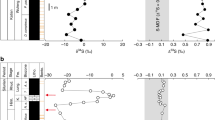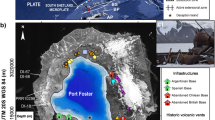Abstract
The first systematic rock sampling of volcanoes along the Galápagos hotspot tracks (the aseismic Cocos, Carnegie, Malpelo and Coiba ridges and adjacent seamounts) in the area between the Galápagos Islands and Central and South America was carried out on R/V Sonne cruise 144-3. Guyot-shaped seamounts, paleo-beach or intertidal wave-cut platform deposits, the structure and texture of volcanic rocks, and low sulfur contents of fresh glasses dredged at these volcanoes imply that ocean islands existed continuously above the Galápagos hotspot for at least the past 17 million years. These new data significantly extend the time period over which the unique endemic Galápagos fauna could have evolved, providing a complete solution to the long-standing enigma of the evolution of Galápagos land and marine iguanas.




Similar content being viewed by others
References
Bowman RI, Berson M, Leviton AE (ed) (1983) Patterns of the evolution in Galápagos organisms. Pacific Division, California Academy of Science, San Francisco
Carroll MR, Holloway JR (eds) (1994) Volatiles in magmas. Mineral Soc Am Rev Mineral 30:1–517
Christie DM, Duncan RA, McBirney AR, Richards MA, White WM, Harpp KS, Fox CG (1992) Drowned islands downstream from the Galápagos hotspot imply extended speciation times. Nature 355:246–248
Christie DM, Werner R, Hanan BB, Wintersteller P, Hauff F, Hoernle K, Shipboard Scientific Party (2001) Galapagos plume-ridge interaction. Part 2: variations in seamount morphology around the Galapagos platform. Eos Trans Am Geophys Union 82(47):F1214
Clague DA, Davis AS (2002). Submarine Strombolian eruptions along the mid-ocean ridge system: the Gorda ridge. Am Geophys Union Chapman Conference Explosive Subaqueous Volcanism, vol 18
Darwin C (1859) On the origin of species by natural selection. Murray, London
Eissen J-P, Fouquet Y, Hardy D, Ondreas H (2002). Volcanoclastic basaltic deposits between 400 and 2,000 m b.s.l. at the axis of the mid-Atlantic ridge south of the Azores. Am Geophys Union Chapman Conference Explosive Subaqueous Volcanism, pp 18–19
Fine G, Stolper E (1986) Dissolved carbon dioxide in basaltic glasses: concentrations and speciation. Earth Planet Sci Lett 76:263–278
Fisher RV, Schmincke H-U (1984) Pyroclastic rocks. Springer, Berlin Heidelberg New York
Gerlach TM (1986) Exsolution of H2O, CO2 and S during eruptive episodes at Kilauea Volcano, Hawaii. J Geophys Res 91(B12):12177–12185
Hey R (1977) Tectonic evolution of the Cocos–Nazca spreading center. Geol Soc Am Bull 88:1404–1420
Hoernle K, Werner R, Morgan JP, Garbe-Schönberg D, Bryce J, Mrazek J (2000) Existence of complex spatial zonation in the Galápagos plume for at least 14 million years. Geology 28(5):435–438
Hoernle K, Bogaard Pvd, Werner R, Hauff F, Lissinna B, Alvarado GE, Garbe-Schönberg D (2002) Missing history (16–71 Ma) of the Galápagos hotspot: implications for the tectonic and biological evolution of the Americas. Geology 30(9):795–798
Jambon A (1994) Earth degassing and large-scale geochemical cycling of volatile elements. In: Carroll MR, Holloway JR (eds) Volatiles in magmas. Mineral Soc Am Rev Mineral 30:479–517
Kellogg JN, Vega V (1995) Tectonic development of Panamá, Costa Rica, and the Colombian Andes: constraints from global positioning system geodetic studies and gravity. In: Mann P (ed) Geologic and tectonic development of the Caribbean plate boundary in southern Central America. Geol Soc Am, Boulder, pp 75–90
Lonsdale P, Klitgord KD (1978) Structure and tectonic history of the eastern Panamá Basin. Geol Soc Am Bull 89:981–999
Meschede M, Barckhausen U (2001) The age of submarine ridges in the eastern Panamá basin: constrains from palinspastic restorations. Int J Earth Sci 90:386–392
Metrich N, Clocchiatti R (1989) Melt inclusion investigation of the volatile behaviour in historic alkali basaltic magmas of Etna. Bull Volcanol 51:185–198
Metrich N, Sigurdsson H, Meyer PS, Devine JD (1991) The 1783 Lakagigar eruption in Iceland: geochemistry, CO2 and sulfur degassing. Contrib Mineral Petrol 107:435–447
Moore JG, Calk LC (1991) Degassing and differentiation in subglacial volcanoes, Iceland. J Volcanol Geotherm Res 46:157–180
Moore JG, Clague DA (1987) Coastal lava flows from Mauna Loa and Hualalai volcanoes, Kona, Hawaii. Bull Volcanol 49:752–764
Moore JG, Schilling J-G (1973) Vesicles, water, and sulfur in Reykjanes Ridge basalts. Contrib Mineral Petrol 41:105–118
Rassman K (1997) Evolutionary age of the Galápagos iguanas predates the age of the present Galápagos Islands. Mol Phylogen Evolution 7(2):158–172
Schmidt R, Schmincke H-U (2000) Seamounts and island building. In: Sigurdsson H (ed) Encyclopedia of volcanoes. Academic Press, San Diego, pp 383–402
Sinton CW, Christie DM, Duncan RA (1996) Geochronology of Galápagos seamounts. J Geophys Res 101(B6):13689–13700
Smith WHF, Sandwell DT (1997) Global seafloor topography from satellite altimetry and ship deep soundings. Science 277:1956–1962
Wallace P, Anderson AT (2000) Volatiles in magmas. In: Sigurdsson H (ed) Encyclopedia of volcanoes. Academic Press, San Diego, pp 149–171
Werner R, Hoernle K, Barckhausen U, Hauff F (2003) The geodynamic evolution of the Galápagos system (Central East Pacific) over the past 20 million years: constrains from morphology, geochemistry, and magnetic signatures. Geochem Geophys GeoSyst (in press)
Werner R, Hoernle K, Bogaard Pvd, Ranero C, Huene R, Korich D (1999) A drowned 14-m.-y.-old Galápagos archipelago off the coast of Costa Rica: implications for tectonic and evolutionary models. Geology 27(6):499–502
White WM, McBirney AR, Duncan RA (1993) Petrology and geochemistry of the Galápagos Islands: portrait of a pathological mantle plume. J Geophys Res 98(B11):19533–19563
Wilson DS, Hey RN (1995) History of rift propagation and magnetization intensity for the Cocos–Nazca spreading center. J Geophys Res 100(B7):10041–10056
Acknowledgements
We thank M. Thöner for technical assistance and D. Ackermand, chief scientist of cruise SO 144/3a, and the SO 144/3a and 3b crews and Shipboard Scientific Parties for the support necessary to carry out this study. J. White and S. Cronin are thanked for their constructive reviews. We thank the governments of Costa Rica and Ecuador for granting permission to work in their territorial waters and on Cocos Island. We also gratefully acknowledge the support of G. Alvarado, B. Sassen, and E. Santana in this matter. This study was supported by the German Ministry of Education and Research (BMBF; Grant PAGANINI).
Author information
Authors and Affiliations
Corresponding author
Rights and permissions
About this article
Cite this article
Werner, R., Hoernle, K. New volcanological and volatile data provide strong support for the continuous existence of Galápagos Islands over the past 17 million years. Int J Earth Sci (Geol Rundsch) 92, 904–911 (2003). https://doi.org/10.1007/s00531-003-0362-7
Received:
Accepted:
Published:
Issue Date:
DOI: https://doi.org/10.1007/s00531-003-0362-7




